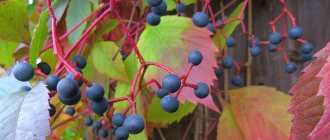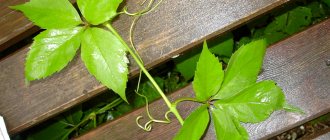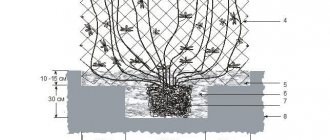Maiden's grape or Vichi is used to form hedges, decorate fences, camouflage unsightly buildings and decorate gazebos and verandas. On a sunny day, in a gazebo entwined with leafy vines there will be shade in which you can hide from the hot midday sun. In addition, the plant has attractive flowers and fruits that can decorate any area. In order for Vici grapes to grow well and quickly, they must be planted and cultivated correctly. We will talk in detail about proper planting and care nuances in our article.
Maiden grapes - description
The homeland of the deciduous decorative deciduous vine is the southwest of Primorye, the Korean Peninsula, China, and Japan. It takes root and grows best in moderate climatic conditions.
The tree-like plant is distinguished by its beautiful green leaves, which turn purple or red in autumn. The length of the lashes of an adult vine can reach twenty-five meters. In the first two years they grow up to three meters. Young shoots are reddish in color, while adults are brown-green. Petiolate palmate leaves on the shoots are arranged alternately.
Well-branched thin tendrils grow from the nodal part of the foliage, with the help of which the vine clings to supports and fences. Small pale yellow or pale green flowers form and bloom on paniculate inflorescences, from which small fruits and berries are formed.
Reproduction
The grapes are sensitive to frost and can withstand short-term temperatures down to -30°C. Sheds its leaves for the winter. Requires shelter for the winter, as it can die in the absence of snow.
Grapes of this variety prefer to grow in sunny or semi-shady places.
Veitchii is highly drought tolerant. Not picky about the type of soil.
Propagated by cuttings, as well as by roots or seeds.
Types of virgin grapes
Liana has several species, each of which is represented by varieties with different leaf shapes.
Ivy-shaped or tripointed
A plant with heart-shaped , bladeless, round, three-lobed or triangular leaves in a bright red, bronze or golden yellow hue. This type of grape is also distinguished by a large number of suckers and branched tendrils. It has elongated clusters of inflorescences that produce unattractive flowers and bluish-black fruits.
The tripoint vine is not winter-hardy, so it is rarely grown in the middle zone. Without shelter, it can withstand short frosts with a temperature of at least -15 degrees.
The most popular varieties:
- Vici grapes are distinguished by small leafy platinums, which can consist of three leaves or be simple. Under favorable conditions, in one season the plant can grow up to four meters and form a thick carpet. In summer its leaves are green, and in autumn they turn a bright red-orange color.
- The golden form of the ivy vine has marbled leaves. Golden-yellow spots seem to be scattered across the green platinum leaf.
- The purple form features dark purple leaves that maintain beautiful color throughout the season.
All varieties of the tripointed species are resistant to exhaust gas and smoke, so they can be grown near the road and used as a hedge .
Virginia or five leaf grapes
A large, shade-tolerant, fast-growing vine grows up to twenty centimeters in length and is distinguished by palmate compound leaves, which consist of ovate or oblong leaves with a pointed tip. The leaf blade is dark green on top and bluish underneath. Young reddish shoots of the plant turn green with age. Umbrella inflorescences consist of three to six flowers, from which blue-black fruits with a bluish bloom are formed by autumn.
The species is winter-hardy , therefore it is widely used in all regions of our country. The most common varieties are:
- Star Showers features marbled foliage. In summer the leaves are green with white spots, and in autumn they are red with pink spots.
- Saint-Paul is a vine with elongated inflorescences, pubescent young shoots and tendrils with twelve branches.
- The hairy form of Virginia grapes has reddish shoots and a leaf plate of the same color, which is pubescent from below.
- The wall form of the vine has a large number of suction cups, thanks to which it is able to climb and hold well even on a smooth vertical surface.
- The Engelman variety is distinguished by its small leaves.
The five-leaf species is resistant to various insects and diseases, tolerates urban conditions and reproduces in different ways.
Description and popular varieties
The Maiden's grape vines reach 20 meters, and their length increases by three meters every year. A powerful root system penetrates deep into the soil and firmly holds the plant. Clinging with tendrils, the grapes rush in all directions and cover any uneven surface.
The leaves are large, palm-shaped, jagged at the edges and reach 10 cm. In summer they become bright green, and darken with the onset of cloudy days. In autumn, the leaves of some varieties turn yellow or acquire a purple tint, and with the first frosts the foliage plays with crimson colors.
Virgin grapes are strewn with clusters of spherical or ellipsoidal berries with a diameter of 5-8 mm. Their skin is thick and elastic, the color is burgundy, purple, dark red and blue. As the grapes ripen, they become black with a bluish tinge. Each berry contains 3-4 seeds. Birds are very fond of grape fruits and eat them during the winter. By spring, the plant looks like a tangle of bare branches with some dry foliage.
The astringent, sour-bitter taste of the berries is due to the presence of oxalic acid in them. They are used in folk medicine, but consumption in large quantities is fraught with poisoning.
In nature, there are 10 species of this plant and only three of them are found in gardens and vegetable gardens: attached, five-leafed (virginian), ivy-shaped three-leafed (triostrum).
Two types are grown in Russia:
- Five-leafed virgin grape (Virginian) has palmately compound, pointed, oval-shaped leaves. It is attached to the support with tendrils and, with normal development, reaches 18 m. In autumn, its foliage turns red. It grows mainly on the sunny side and tolerates winter cold.
- Tripointed (ivy-shaped) grape with three palmate leaves. Its shoots with a dozen tendrils grow up to 15-20 m. The plant is firmly attached to the support using suction cups. Adapts well to cold weather, but is less frost-resistant than five-leaf grapes.
Ornamental grapes are called "maiden ivy" and "virgin ivy" because their flowers do not need to be fertilized by pollen.
Table: Popular varieties of virgin grapes:
| Name | Foliage color in summer | Leaf color in autumn | Liana length, m | Lifespan, years | Variety |
| Yellow wall | Green | Yellow | 10−15 | 20 | Five-leafed |
| Raspberry wine | Green | Red, crimson, orange-red | <15 | 16−18 | Ivy-shaped |
| Don Juan | Green | Purple, crimson | 15−20 | 18−20 | Five-leafed |
| Vici Boscope | Light green | Bronze red | 8−12 | 12−16 | Triwall |
| Serenade | Green | Purple | <20 | 15−20 | Five-leafed |
Vichi grapes have pronounced decorative properties. Its leaves are small in size and have a shiny surface. With the onset of the first cold weather they turn orange.
Advantages and disadvantages
The grapes protect the house from the scorching sun, so it is always cool on hot days. And on a rainy day, foliage protects from rain and wind.
Advantages:
- attractive appearance;
- unpretentiousness to soil and place;
- rapid growth: 3 m per year;
- thick curtain - protection from dust;
- reducing humidity in the room and around the foundation;
- winter hardiness.
Many gardeners believe that they need to plant Virginia grapes to hide the ugly facade of a house or to cover an old barn. And others are sure that this plant leads to the destruction of walls and foundations.
Flaws:
- An unkempt plant grows and penetrates under the slate, causing it to crack and clog the drainage system.
- Long roots spread several meters and suck nutrients from the soil. As a result, the survival rate of cultivated plants is minimal.
- In spring it becomes covered with leaves later than other garden plants, so its dry branches look unsightly.
Use in landscape design
The plant is used as a hedge; it camouflages compost heaps and septic tanks. Any dried tree can be transformed if it is entwined with a grape vine.
Recommendations:
- Use with caution near dilapidated structures.
- Planted near brick, concrete and wooden walls.
- It is not advisable to plant the plant near the wall of a house with a slate or tiled roof.
Virginia grapes look impressive when planted in moisture-permeable, fertile soil on the south side of the site. And, conversely, the foliage of a plant planted from the north is faded.
Combination with other plants:
- The stems and roots of clematis are protected from the sun under the vine and this proximity benefits it.
- The dull green foliage of the Aureus hop variety is accentuated by the vines of the maiden grape.
- Climbing rose grows well on a support of vines.
- In winter, the vine loses its foliage and attractiveness. Coniferous plants planted in the foreground distract attention to themselves.
Planting Vicha grapes
The plant will grow well in both shade and sun and is not picky about soil. Therefore, you can sow seeds or plant seedlings in any area of the garden. However, the growth of grapes and the color of their leaves directly depends on the light. In the sun their colors will be much brighter than in the shade. It is not recommended to plant the plant in an area where a cold wind blows.
The soil for Vichi virgin grapes is loamy, slightly alkaline, slightly acidic or neutral. Before planting seedlings, dig up the soil and remove plant debris from it.
Drainage in the form of pebbles, crushed stone or broken bricks is poured into the prepared holes The drainage layer is covered with medium-grained sand and nutrient soil. For the vine, you should prepare the soil from the following components:
- compost - 2 parts;
- garden soil - 2 parts;
- sand - 1 part.
After planting in the hole, the seedling is watered abundantly.
Growing grapes
The tripointed Vicha grape is picky about the type of soil. You cannot plant bushes on acidic soils. The optimal acid level is 3%. Planting is carried out both in shaded areas of the garden and in well-lit areas. The only difference is the quality of growth and leaf color. Plants located in sunny areas are taller and their leaves are brighter.
To protect from the wind, grapes are planted next to the fence. Within 3 years, the stem of the vine becomes so strong that it becomes unaffected by gusts of wind.
Before starting spring planting, the entire area is dug up. During the procedure, weeds and their roots are removed. This is done for better plant growth.
The holes should be 20 cm deep. A drainage system is installed at the bottom: it will remove excess moisture. The drainage is sprinkled with sandy soil and humus (5 kg of sand and 1 kg of humus are poured into each hole). At the end of planting, the wild bush is watered with 10 liters of warm water and compacted well. The distance between bushes should be 2 m, and between rows - 2.5 m.
Features of care
Caring for Vichi grapes includes regular timely watering, weed removal, fertilizing and pruning vines.
The plant should be watered only three to four times per season , but if the summer is hot and dry, more frequent watering will be needed. Each bush will need one bucket of water.
At the beginning of summer, the vine is fed with nitrophoska, and at the height of growth in the middle of the season - with complex fertilizers with minerals. After watering, the beds with plants are freed from weeds and loosened. Bare roots are covered with earth.
Mulch, which can be spread around the plants, will help retain moisture, nourish the bushes and prevent weeds from growing . To do this, you can use peat , humus or compost, spreading them in a layer six centimeters thick.
Pruning vines
When caring for Vici grapes, branches are pruned throughout the season, with the help of which the plant is formed. In summer, green shoots can be pruned, and woody branches can be pruned in autumn.
When propagating by seeds in the first three years, pruning may not be necessary, since the plant is still small at this time. Subsequently, the shoots are removed in order to form a reasonable density and a certain shape of the bushes. The cut using pruning shears should be made over a healthy kidney.
After the formation of the main skeletal branches, in the future, when caring for the vine, you will only need to limit the growth of shoots and carry out sanitary pruning. The bushes should not be allowed to grow too much, otherwise they will turn out to be ugly, sloppy thickets.
Caring for Vici grapes in winter
In warm regions, the tripoint vine overwinters well. But in areas with little snow and cold winters, it may die. To protect it from freezing, you should first lay mulch under the bush, and then spruce branches and plant lashes. The branches are covered with spruce branches on top . At the same time, you need to make sure that the bush does not dry out on warm days.
Plant care
The plant needs annual pruning
Watering Vicha grapes is carried out at intervals of a month. If the plant is grown in a hot climate (central and southern regions of the country), the interval is reduced to 2 weeks. It is better to water the plant in the morning, while the sun has not risen high. 10 liters of warm water are poured under each tripointed bush. After 2-3 days, loosen the soil and destroy all weeds.
Features of feeding
Tripointed grapes of the Vichi variety need high-quality fertilizing. 20 days after planting, nitrophoska is applied under the plants (100 g for each bush). During the period of active growth, fertilizing consists of using phosphorus components (40 g of superphosphate per 10 liters of water). When fruit sets, the bushes are watered with a solution of ammonium nitrate (30 g of the drug per 10 liters of water).
How and what you can feed little rabbits with and without a female rabbit: diet and feeding standards
Trimming
Shoots of the Vichi variety require annual pruning: it allows the formation of bushes. In the summer, green shoots are removed, and in the fall, all diseased and damaged areas are cut off. The desired number of eyes is left on each shoot.
In late autumn, the entire plant is covered with plastic film or agrofibre to prevent frost from damaging the structure of the bush.
Propagation of Vici grapes
Liana can be propagated in several ways:
- seeds;
- cuttings;
- root suckers;
- layering.
Seed propagation
Sowing seeds can be done both in spring and autumn. Pre-planting material must be prepared by keeping it for one and a half months at a temperature within +4 degrees. After this procedure, the seeds will sprout in about three weeks. Stratification is carried out when planting seeds in the spring. And the seeds collected in the fall can be immediately sown in the prepared bed.
Propagation by cuttings
By cutting cuttings from last year's lignified ones in spring and summer, you can use them to produce new plants. For better rooting, cuttings with small outgrowths, which already contain the rudiments of future roots, are used. Cuttings with two to four nodes can be rooted in water, but the best results will be when planted in the ground.
Before planting, the cuttings are treated with special preparations that stimulate the formation and growth of roots. The containers are filled with a mixture of peat and sand, into which the cuttings are buried. Spring prunings need to be buried to the bottom node, and summer prunings should be buried so that there are at least two buds underground.
Caring for new plants consists of good lighting and timely watering. Until next spring they are grown in a warm room, after which they are planted in open ground.
In regions with a warm climate, grape cuttings can be immediately planted in the garden bed by digging holes seven to ten centimeters deep for them. The distance between plants should be at least one and a half meters. At first, cuttings that have not yet taken root need shading and timely watering.
Reproduction by root suckers
With this method of propagating grapes, root shoots are dug out of the soil. They are first planted in a temporary bed, where they grow for a year or two. When planting the offspring, you need to make sure that the neck of the plant remains at the same level as it was. The grown and strengthened bushes are transplanted to their permanent place.
Reproduction by layering
Experienced gardeners propagate Vichi grapes by layering. To do this, the whip is pressed and fixed to the ground. The area with the buds is sprinkled with nutritious soil. For a short branch, a groove is dug into which the whip is completely placed. Only the top, about twenty centimeters long, should remain. Until the cuttings take root, they need to be watered regularly. When they send out new shoots, the young plants are separated from the mother bush and planted in a new location.
Characteristics of grapes
The decorative grape variety Vichi is used to decorate buildings or fences. He weaves along the walls, gradually rising upward. Vici grape variety is tall. Its vines grow up to 20 m in height, which allows them to wrap around any wall. During the year, the plant grows 5 m. The growing season lasts 5 months.
Tomato variety “Wild Rose”: description, characteristics, sowing seedlings, fertilizing, yield, photos, videos and the most common tomato diseases
Features of the plant
According to the description, Vici grapes have the following characteristics:
- the leaves are small in size and green in color: in the fall they begin to acquire a rich red tint and the appearance of tiles that cover the roofs of houses;
- the leaves have a smooth, dense surface with an average wax coating;
- on one plant the leaves take on different shapes (round, elongated or heart-shaped);
- The flowers are small, have white petals with red spots:
- the plant blooms from mid-summer to mid-autumn.
Description of the fruit
The round berries of the tri-pointed variety are small in size, purple. The diameter of each fruit is 1 cm. Inside the berry there are 2 seeds.
The bunch is cone-shaped, weighing up to 1 kg.
The fruits are not suitable for consumption either fresh or as part of dishes.
Pests and diseases
The plant is resistant to various pests and diseases. But if you find settled insects on its leaves that feed on the juices of the plant, then insecticidal preparations can be used to destroy them.
If not cared for properly, the roots may begin to rot. The fact that the plant is sick will be indicated by diseased leaves and shoots. They need to be removed, the bush should be treated with fungicides and the care of the grapes should be reviewed.
Vichi virgin grapes, like other types of this plant, do not require special care and are able to reproduce on their own. Even a novice gardener will be able to plant and grow this crop on his plot, using it to decorate a gazebo or veranda, cover a utility block or shed, or decorate a fence or wall of a house.
Kinds
As noted, there are about 10 varieties of virgin ivy, but two types are in demand in Russia.
Tripointed (ivy-shaped)
This variety is a fast-growing vine that produces a dense canopy of leaves. It is fixed to the surface using suction cups, so it does not require any other support. Easily copes with smoke and air pollution.
At the ends of the shoots there are up to ten tendrils (it is they that are attached to the surface). The height of the shoots reaches 10 meters. The ivy-shaped variety is less resistant to frost than the five-leaved variety.
Five leaf
Five-leaf maiden grape
The plant is a vine strewn with numerous oval leaves with sharp edges.
This variety of maiden grapes grows quickly, so it needs a support to which the vine is attached with the help of tendrils.
On average, the length of the shoots reaches 18 meters. Flowering time is summer. The fruits are inedible. With the onset of autumn cold weather, the leaves turn red. The peculiarity of the grapes is its good resistance to frost.
Ornamental grapes propagate, like their cultivated relatives, by seeds, cuttings and seedlings.
general description
The botanical name of the virgin grape is Parthenocissus, which translates to “virgin ivy.”
This name is due to the biological characteristics of the plant: the structure of the leaf plate resembles ivy foliage. And the word “virgin” indicates the ability of flowers to form fruits and seeds without pollination. In nature, virgin grapes are widespread in East Asia, North America and the Himalayas. By the way!
Gardeners call these grapes “wild” for their extraordinary endurance, vigorous growth of shoots, winter hardiness, and unpretentiousness to growing conditions. All of these characteristics are akin to plants found in the wild.
Grape shoots are long flexible vines, the length of which can reach 25-30 meters. They can grow upward, clinging with suction cup tendrils to a vertical surface, or spread along the ground, enveloping with branches all objects in their path. At the same time, the branches have extraordinary fastening power - it is almost impossible to tear such a vine from a fence or wall of a house with your hands. One-year-old grape shoots are green, thin and flexible. With age, the shoots become woody, the bark acquires a golden color. In summer, each shoot is densely overgrown with large palmate foliage. It comes with three, five and seven fingers. Grows on long petioles. In the warm season, the leaves are dark green. Some varieties have glossy leaves, others have matte, rough leaves. By autumn, the color of the leaves changes to yellow, red and purple.
Fact! Leaves are the main decoration of girlish grapes.
The liana blooms at the end of June and blooms until mid-August. The inflorescences are small, unremarkable. They are difficult to notice against the background of large star-shaped leaves. At the beginning of autumn, the flowers give way to pea-shaped fruits.
The fruits of the plant are small round berries. Their diameter is no more than 8 millimeters. The fruits on the branches are collected in small clusters of 10-12 pieces. Berry seeds can be used for seed propagation of grapes. The peel of the fruit is dense and thick. Depending on the variety, the color of the berry can be red, blue, burgundy or purple. When ripe, the color of the fruit is always the same - dark blue, almost black with a slight matte whitish coating. The fruits are unsuitable for consumption, as they contain a large amount of oxalic acid, which gives the berries bitterness and acidity. Moreover, the berries can cause serious poisoning.
Rules of care
Maiden grapes are one of the most unpretentious crops that can be grown in open ground conditions. The gardener will only need to water the plant in severe drought and carry out sanitary treatment of the vines in a timely manner, since without pruning very soon this beautiful plant will turn into continuous thickets.
Since in our country it is customary to grow only frost-resistant varieties, there is no need to cover the crop for the winter. Even if some of the lashes freeze, you can always remove them during sanitation, and in their place young and beautiful shoots will very quickly appear from the buds. Just remember that the lashes must be cut back to healthy wood, otherwise there will be no point in processing the plant.
During the first few years, the liana actively develops the root system, so during this period it is especially important to feed the plant with complex fertilizers twice during each growing season. Initially, the young vine is tied up and guided by the gardener himself, however, after some time, the vine will begin to cling to the support not only with tendrils, but also with aerial roots for any roughness on the surface.











